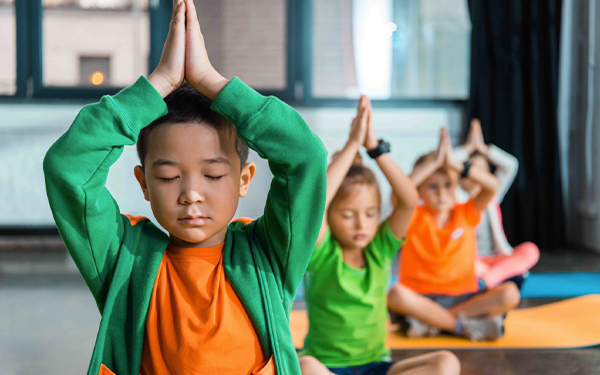Mindfulness: How Staying Calm and Collected Can Improve Focus and Cognition
Home »

Mindfulness: How Staying Calm and Collected Can Improve Focus and Cognition
Practicing mindfulness techniques at home with your child can be a great way for them to improve their focus, cognition and overall well-being. Not only is mindfulness practice beneficial, but it is also simple to exercise at home, which makes this a great activity for parents and their children to do together.
In this month’s edition of Thrive, we will discuss the benefits of mindfulness and how you can practice it at home with your child.
Mindfulness is a somewhat broad term that can include a wide range of activities, including yoga, meditation, taking deep breaths, hugging and even eating. The point is more about calming one’s self and being aware of one’s body and surroundings than the actual activity.
Beneficial and Easy
According to Psychology Today, practicing mindfulness can help children in these seven ways:
- Strengthening focus and ignoring distractions
- Handling stress
- Staying calm when faced with challenges
- Lowering social anxiety and stress
- Increased patience
- Improved cognition and memory
- Improved attentiveness and impulse control
“For children, mindfulness can offer relief from whatever difficulties they might be encountering in life,” author and mindfulness coach Annaka Harris told the New York Times. “It also gives them the beauty of being in the present moment.”
And these benefits aren’t limited to children, of course. When practicing mindfulness with your child, you can reap the benefits, too.
Here are some ways to get started.
Simple Tasks
KidsHealth.org lists four ways you can practice mindfulness: Eating, breathing, walking and concentrating on a single word.
For example, when practicing mindful breathing, sit in a comfortable position and take deep breaths, concentrating on the air going in and out of your body. If your mind starts to wander, revert your focus back on your breathing.
Mindful eating is similar in that you concentrate on the sensation of the feel, smell and taste of the food. If eating an orange, concentrate fully on how it feels in your hand, paying attention to the smoothness of the skin or the stickiness of the pulp. Afterward, take in the smell and then the taste the same way – by concentrating on each aspect and allowing your mind to engross itself on a simple task and, in effect, calm itself.
Games
Games are another way to practice mindfulness.
PositivePsychology.com lists five mindfulness games for children. The first – and easiest – game is balancing on one foot:
- Tell your child to focus her gaze slightly below eye level.
- Tell her to stand on one leg and keep her gaze fixed on that focal point.
- Challenge her to see how long she can stand on one leg like this.
- Tell her to try the other leg.
- Challenge her to stay focused while you engage her in conversation, ask her to sing a song, or tell her to close her eyes.
Meditation
Although it might not seem like it, childhood is a great time to start practicing meditation.
Author and yoga teacher Jillian Pransky lists three simple meditation techniques that work great with children. The first is called “Elevator Down,” in which you imagine an elevator going down, starting at your head and ending at your feet.
Begin at the crown of your head. On your next exhale mentally chant “three” as you imagine the elevator lowering from your crown to your chest. Pause for an inhale. When the doors open, imagine your breath coming in and freshening up the elevator, the way opening a window brings a fresh breeze into the room. On the next exhale, mentally chant “two.” Imagine going down another flight to your belly. Continue to the ground floor, chanting “one.” Pause and feel your seat on the ground floor and enjoy landing fully.
Learn More
For more information about practicing mindfulness at home and to learn more about its benefits, Annaka Harris’ website has lessons and techniques. You can also visit the Child Mind Institute’s website for research-based information.
